
Crickets chirping against a silent night. A herd of elephants approaching a gigantic river with a golden sunset in the horizon. Hornbills making an occasional appearance on the trees along the river bank. These sights and sounds don’t usually come to mind when you think about holidaying in Bhutan. So when the Tourism Council of Bhutan invited me to experience a ‘Jungle Getaway’ – we set off on a journey to Bhutan’s foothills.
I had seen pictures that people had uploaded on social media of their time in Manas. Ever since then, I had been curious to know more. But there wasn’t much online besides reports from the Ministry of Agriculture and Forests and the Tourism Council. But as a local tourist I was interested in finding out what sights and activities the region had to offer. So the best thing to do was go there and experience it myself.
Travel to Zhemgang District
Going to Bhutan’s Manas region takes you to Gelephu town in southern Bhutan (a six hour drive from Thimphu). Highlights of the drive to the south? You’ll come across a tunnel, an hour after crossing Wangduephodrang town. Bhutan doesn’t have such infrastructure. It’s quite exciting for locals to drive through the 1 km tunnel.
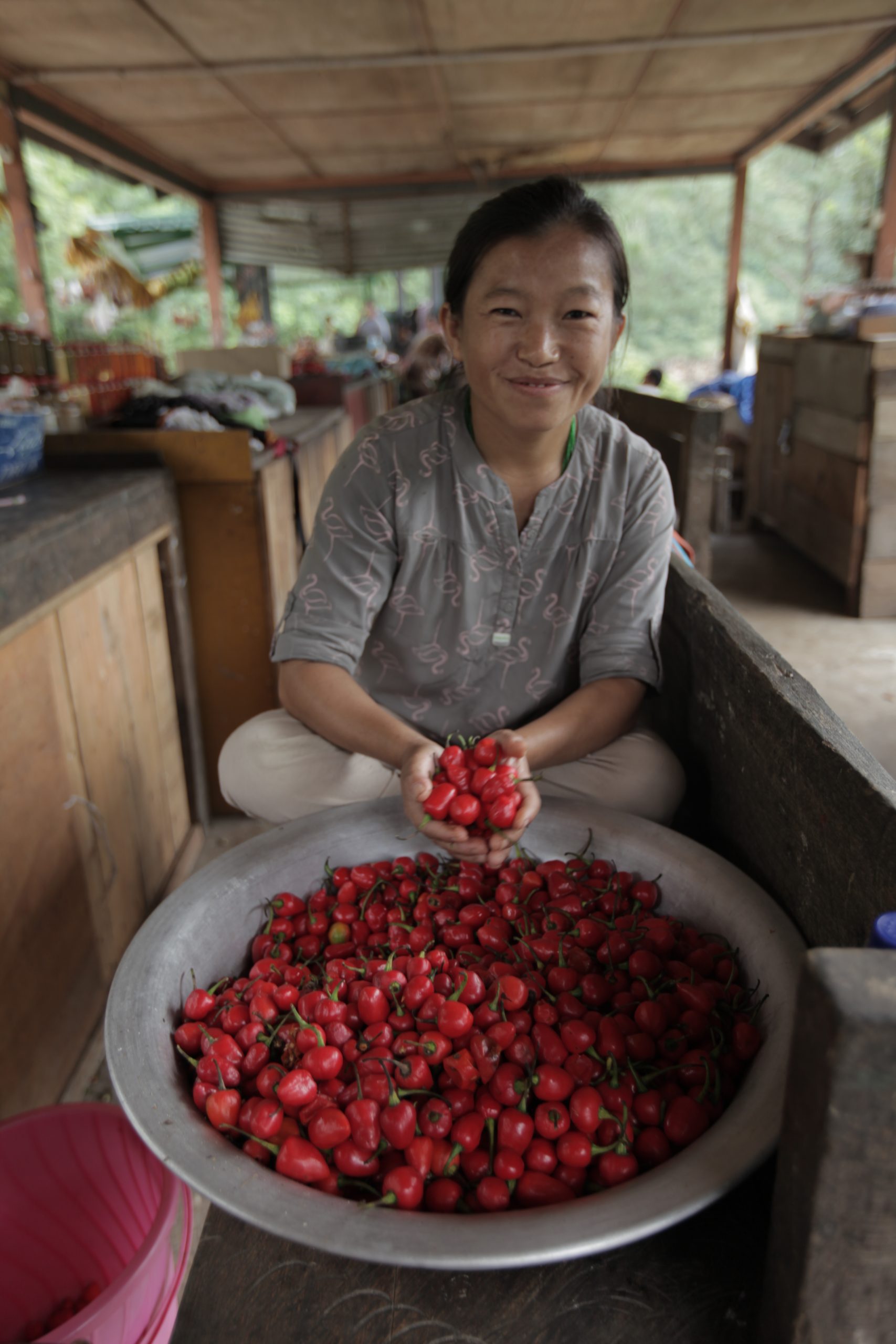
My favourite part of the drive? The local pickle and organic market along the highway before reaching Tsirang town. These stalls are run by local women in the villages around the highway. And they have some of the most authentic local foods. You’ll find wild honey, exotic fruits, spice and so much more. But the hero of the market is the long line of homemade pickles displayed in lines of glass jars. You’ll find all kinds of pickles from bamboo shoot, mango, bird’s eye chilies, tree tomatoes to the famous Daley chili pickle.
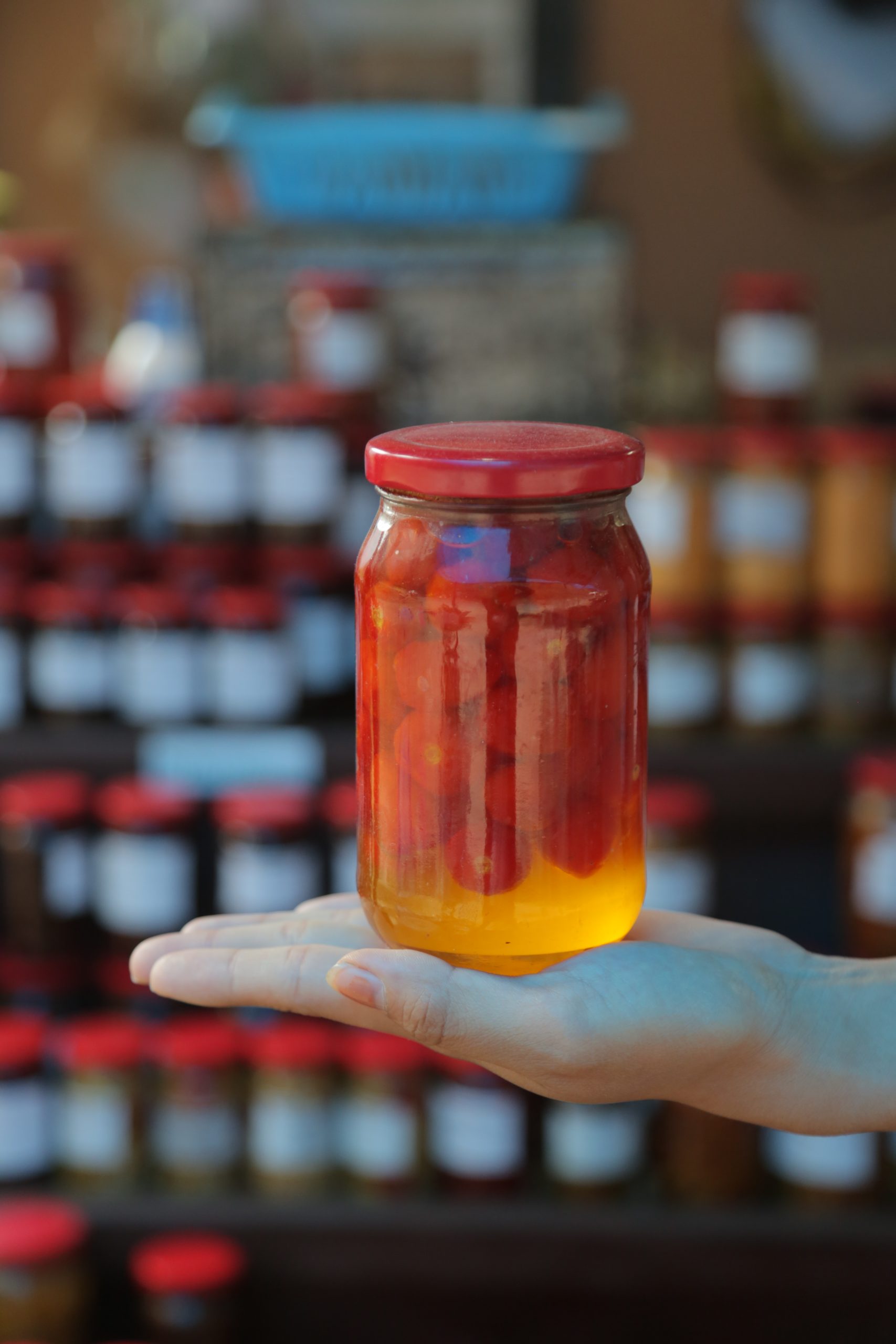
Arriving at Panbang Marangdut Eco Lodge
So after a one-day and nine- hour journey through Tsirang, Gelephu and Tingtibi, we finally arrived in Pangbang. Panbang is a quaint little town under Zhemgang district, closest to the park and where our lodging is located. After meandering through sharp turns on roads, the famous twin waterfall of Panbang greets you along a wide straight highway. The waterfall is a beautiful sight. Take a break from the drive and enjoy it.
We arrived at dusk so it was difficult to discern what the small settlement looked like. Besides the glimpses of glimmering lights coming from oil lamps in small elevated bamboo huts. After calling the lodge for directions, our bus entered the road left from the bridge. This also takes you to the main town of Panbang. Soon we entered the property of the jungle Eco lodge.
As soon as we stepped out of our bus, Sangay our host greeted us and led us to the outdoor lounge near a creek. The eco lodge is a unique kind of stay I had never experienced in Bhutan. Sangay is a local and a ‘Khengpa’, the indigenous people of the Kheng region in Zhemgang. He is also one of the founding members of the River Guides of Panbang. He told us the story of the creation of the Jungle Lodge, as we enjoyed warm tea and biscuits at the lounge.
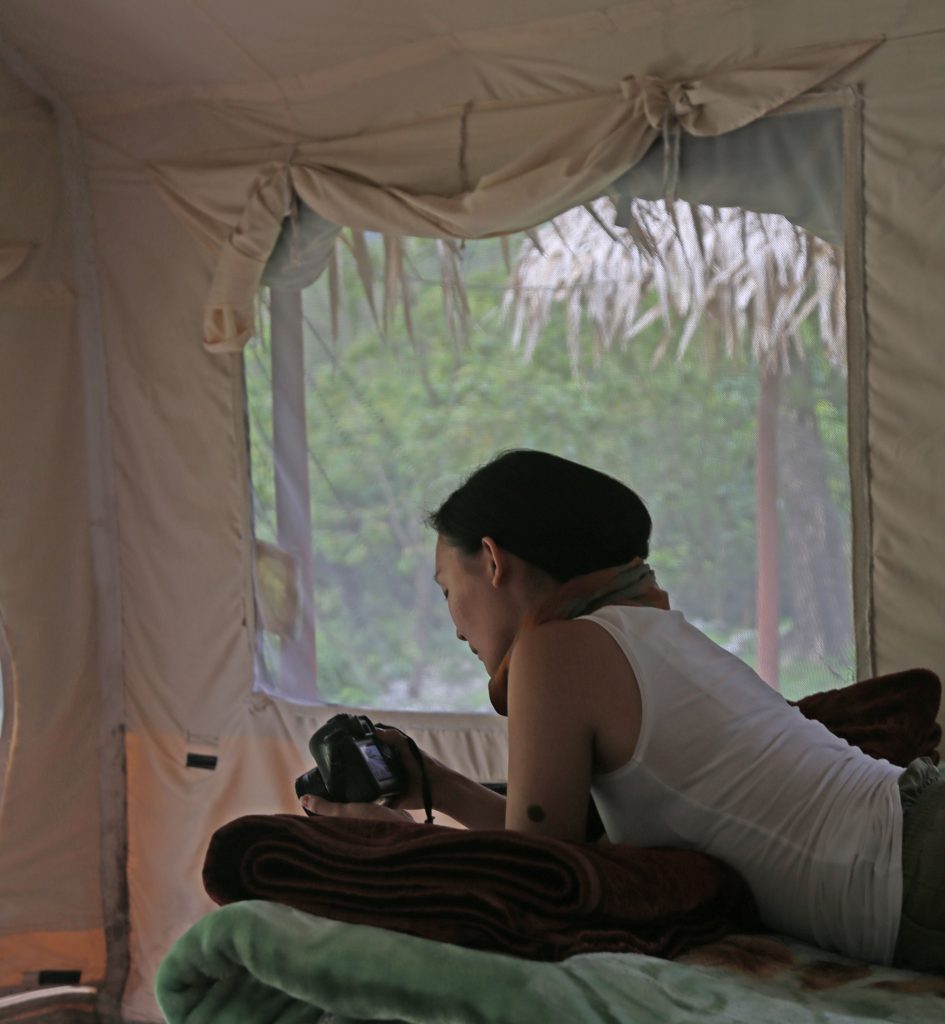
The River Guides of Panbang are community-based river rafting company that specializes in ecotourism in Panbang. The jungle lodge is a dream project by the River Guides of Panbang that started in 2016. The Marangdut Jungle Camp is Bhutan’s first true jungle camp located near the subtropical forests of Royal Manas National Park. The lodge has a unique blend of a jungle safari look and a traditional Khenpa aesthetic. “All the structures are covered with thatched roof made in the traditional Khenpa style. In fact, local villagers helped us out with the traditional thatched roofing. It is a craft that has almost disappeared as corrugated iron sheet roofing has replaced it,” said Sangay.
If you’re interested in a unique stay in the jungles, you’ll the Marangdut Jungle lodge. I’m shown what looks like a Khengpa hut from the outside but with an interesting design. The hut has a tent inside with two solid beds. The mosquito net lining around the tent, comfortable mattress and bedding are enough to cheer us up from the tiring road trip. The sound of the river near the lodge, and the chirping crickets orchestrated a perfect background score as the night swayed us into a deep slumber.


River Rafting in Manas
I woke up feeling so rejuvenated the next day. The sound of the river below the camp and the sounds of the jungle at night felt like a lullaby. As I stepped out of the tent and enjoyed the view from the small balcony outside the tent, I smiling kitchen staff came by with a cup of tea.
The bathrooms at the camp are seperate structures behind the tents. I found myself looking out for creepy crawlies around the toilet. One of the girls told me about spiders on the washroom sinks. Well, we are in the “jungle” I thought to myself. After that ordeal, I was delighted to be welcomed with a breakfast spread – Marangdut style. Fried rice,with fresh azey and boiled eggs. “So what are we doing today?” asked Karma, my friend and co-host for the getaway episode. “Eat up. We are going river-rafting.” I told him.
We packed our equipment and set off towards the bridge in Panbang. The starting point for the rafting session was at the riverbank under the huge Nishoka bridge. I got excited as I put on the colorful life jackets and helmets near the huge Manas river. We awaited our guide’s instruction on river rafting and then slowly headed towards the raft. Rafting experience is not required for any Panbang river trips, we are told. Every rafting trip with RGP has been designed to be comfortable and accessible to almost any beginner.
“If you fall off your raft, do not panic as we will throw a rescue buoy.” I looked at the gigantic Manas river and got a little nervous at the thought of falling in it. The water had a strange muddy emerald green color to it. Unlike the fresh water rapids, this one was not clear at all. But one must try everything once I reminded myself. We finished shooting our intro segment and hopped right onto the raft.
“Here we go!” yelled Karma excitedly. He enjoys such adventures as was apparent by his constant movement on the raft. Soon he was sitting on the tip of the raft posing like a meditating monkey. If you enjoy tumultuous rapids then you might not like this ride. The Manas river does not have the terrifying rapids like the Phochhu in Punakha. But the smooth ride on a gigantic riverscape with the occasional sighting of the famous Manas hornbills is a rare outdoor experience.
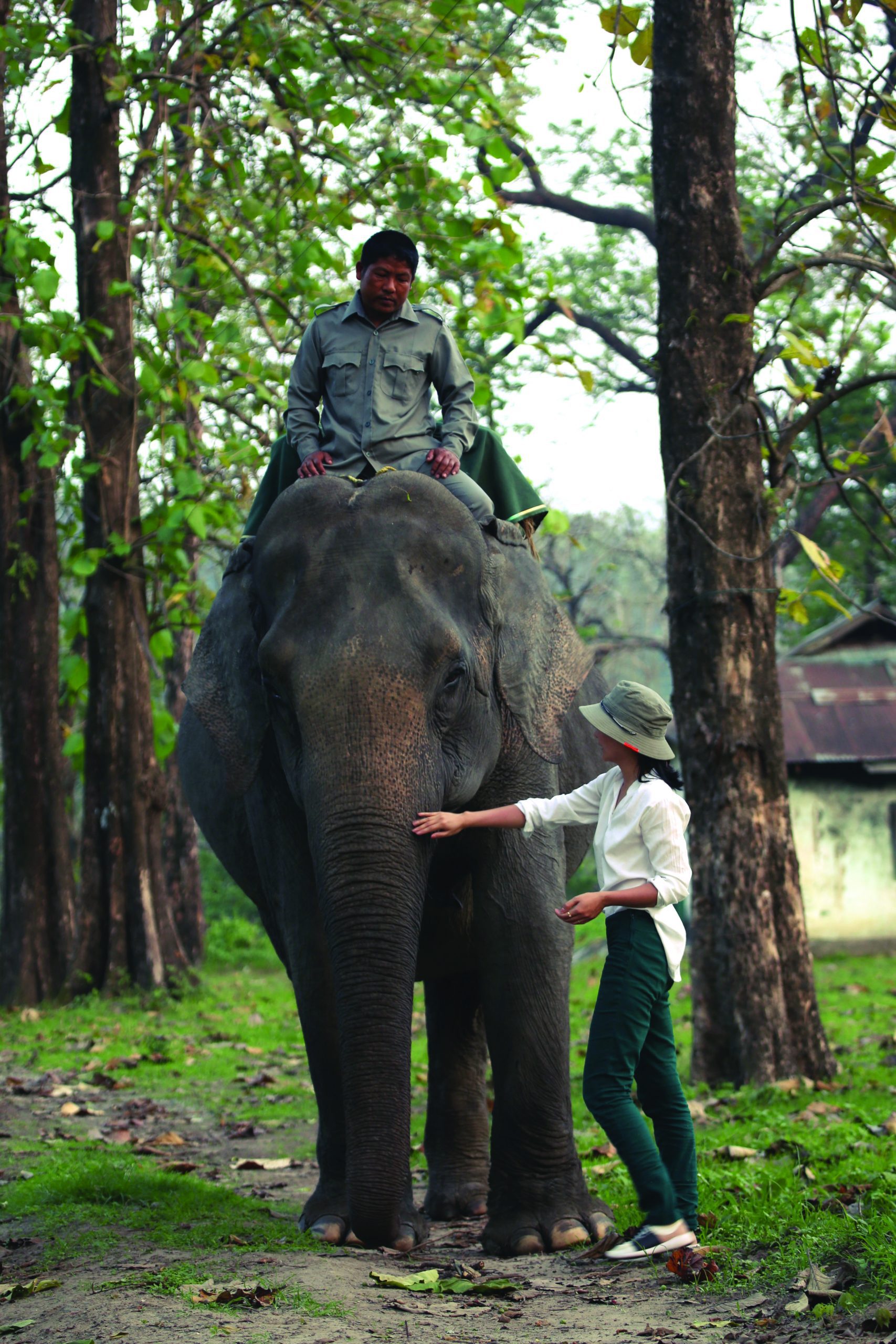
Manas National Park
The MNP office compound is located on top of a small hill right above the bank where we stopped for lunch. The Royal Palace is also located within the territory. Growing up, I had heard lots of stories of how His Majesty would bring Their Royal Highnesses for wild safaris.
The park compound is a cluster of rundown houses that once served as guest houses. There are also offices under the department of Forest and Park services. As we made our way into the property, we came across small houses dating all the way back to the 80s. They had moss-covered walls as if blending into the environment. The sighting of mango and tamarind trees instantly got everybody picking up stones and launching them at the fruits, like children. From biting into the small hard mangoes, to walking by the small houses – all these moments gave me a sense of nostalgia as I reminisced about my childhood in the warm foothills of Sarpang.
You’ll also see squirrels scurrying on the tall trees, monkeys and a deer. Yes, a deer. We were excited to see all of these animals at the park, but we had come there for something else. For years, the park has taken care of several elephants that are raised by the community at the park. “They’re on their way here,” the park officer said. After waiting for seemed like hours, we saw silhouettes of the animals in the distant horizon. I picked up my camera and made my way towards the small clearing in the middle of the compound. They were preparing to feed the elephants here.
Elephant Sighting at Manas National Park
My heart was beating so fast as I approached the beautiful creatures. In no time, the small silhouettes had turned into a tall 10 feet giants standing in front of me. ”There are three females and one male,” described Dawa, the Park Ranger. “Would you like to go for a short ride on the elephants?” asked the staff.
How does one climb on the back of an elephant? There is a staircase that leads you to what looks like a diving board except there is no board. The elephant is positioned right at the end of the platform of the staircase and get on his back. If you’re someone who’s scared of heights then balancing yourself on the saddle can be quite tricky. All you have are two stretches of rope around the wild back for you to hold on. But the small cushioning and the wide surface is good enough to get your grip. Make yourself comfortable on the back of the beautiful beast. Then the short tour around the edge of the jungles of the park began.
Elephant rides are surreal. The motions of the giant beast’s movement as you hang on is quite an experience. And you’re also privy to the sounds of giant showers of the elephant urinating during the ride. That’s right. It sounds like someone let out water from a big tap. Amidst all this, we came across a herd of water buffaloes that were taking a dip. They were all inside a small pool of muddy water cooling themselves. The Specialthang Nature Trail is the trail taken for elephant rides. “Such sightings are not everyday,” our elephant rider said pointing at the water buffaloes. Soon we were heading back as it started getting dark. The jungle grew thicker as we were riding into the trail. But the short ride was enough for us to be thankful for having experienced it.
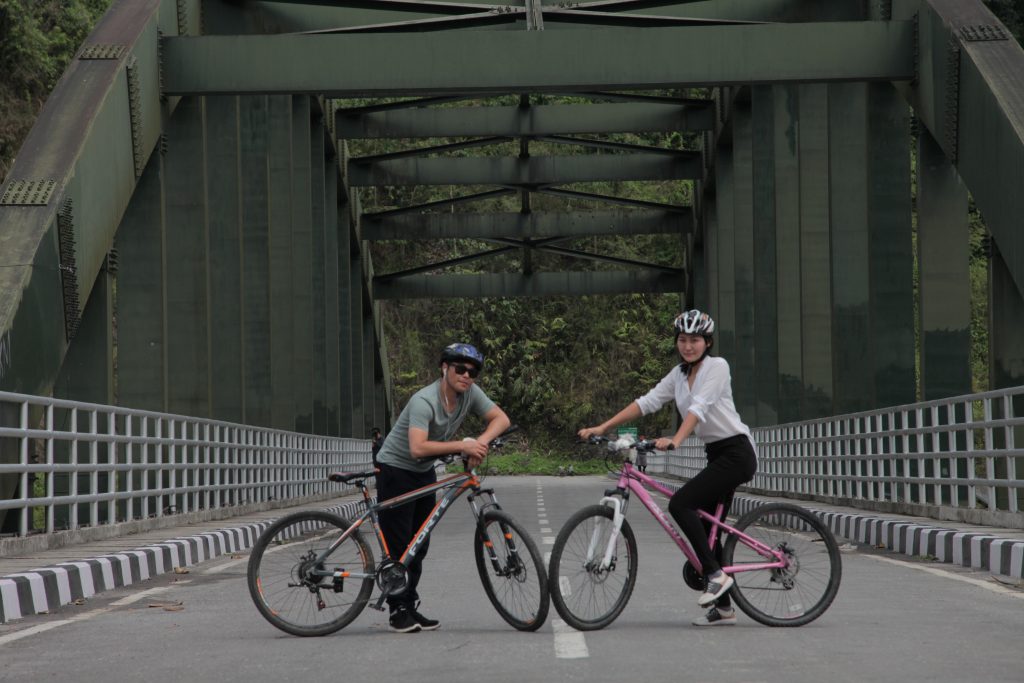
Bike Rides around Panbang Community
More outdoor activities followed the next day. The first was bike rides in the morning from the jungle camp to the bridge. The smooth roads and few cars in Panbang are ideal for an easy bike ride. Soon I found myself away from the group and riding alone towards the bridge. Khenpa farmers walking on the side of the road along with cattle greeted with a smiling Kuzuzangpo la. I realized that I don’t usually do this. Greeting strangers felt nice – something that is quite lost on us today. So I started greeting everyone I met along the highway with a loud enthusiastic Kuzuzangpo la as I rode on. Some returned the greeting while others looked perplexed at this strange over-enthusiastic tourist. I reunited with my group and stopped by the bridge to take lots and lots of pictures.
Swimming Along Fishes in Clear Panbang Rivers
Post lunch, Sangay told us to take a swim in the freshwater creek in front of the lodge. “It’s perfect on a hot day. In fact a lot of locals come here for a cool dip in the water as well,” he explained. He was right. There were small pools in different sections of the creek. Like makeshift dams made from piles of stones. The water was crystal clear but the best surprise were the small fishes swimming around the pool.
But there was something different about this school of fish. As we dipped our feet into the water, the fishes were swimming towards us like curious water creatures. Unlike most fishes that swim away at the slightest of splashing, these tiny fishes were swimming alongside us. A few even got so close to my feet and started nibbling on my toes. Bring your water goggles to have a better experience of seeing the tiny fish swimming under the clear water.

Tongba – Local Khengpa Alcohol
It was our last night at the camp. As a sweet gesture, the wonderful people at the Marangdut Jungle Eco Lodge had planned a small farewell feast. Bamboo shoot soup, local chicken, fresh azey and a steamed Pomfret surprise wrapped in banana leaves. Fresh herbs from their own kitchen garden were sprinkled on the fish. It was delicious. The dinner was then followed by a round of the local speciality – Tongba. “We Khengpas love to drink. This is a special drink that we serve our guests.” said Sangay. Soon we were served what looked like tall bamboo containers full of millets moistened by the alcohol at the base. The drinks even come with bamboo pipes to sip the alcohol below the rim of millets.
The night went by with hysterical laughter from a drunk bunch echoing into the night. I made my way back to my room in a dizzy state. After tossing and turning, I closed my eyes listening to the crickets chirping in the otherwise silent night. I wondered when I would be able to visit the tropical paradise again. Manas in Panbang is definitely worth a second visit.